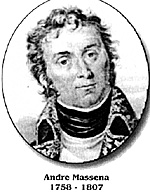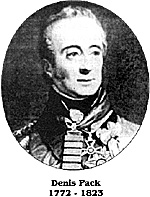 Andre Massena 1758-1807
Andre Massena 1758-1807
The fortress of Almeida, which still stands isolated behind it's imposing Vaubenesque walls, lies just within the Portuguese border amid a broad, undulating plateau. It had been captured by the French in August 1810 as a prelude to their third invasion of Portugal. Though the French, "l'armee de Fortugar, had subsequently been driven back into Spain in April the following year, Almeida remained in French hands.
Wellington' Anglo-Fortuguese army, however, had blockaded the fortress and it's fall was inevitable as an attempt by the French to relieve Almeida had failed, when the opposing armies had met at Fuentes d'Onoro.
Marshal Andre Massena, the commander of the French forces, seeing no hope of saving the garrison, decided to order the Governer of Almeida to destroy the fortifications and abandon the fortress. Massena offered a reward of 6,000 francs to any man who succeeded in carrying a cyphered message through the Allied lines to the Governer, General Brennier, and three volun- teers were found. Two of these volunteers, Zaniboni and Lami, disguised themselves as Spanish peasants but both were discovered and shot as spies. The third volunteer, a private of the 6th Leger named Tillet, remained in uniform and passed the Allied pickets by creeping along a ravine during the night of 6th-7th May.
Brennier signalled receipt of the message by firing three heavy salvos from the ramparts. Upon hearing the signal Massena, in the knowledge that Brennier would now try and escape, moved his army away from the vicinity of Almeida with Reynier's 11 Corps receiving instructions to halt beyond the bridge at Barba del Puero to cover the retreat of the garrison.
With the departure of the French army, Wellington was able to allocare the whole of General Campbell's 6th Division to the blockade. Campbell placed his three brigades in villages some three or four miles from the fortress, the whole being linked by a thin cordon of pickets. Pack's Independant Portuguese brigade also formed part of the blockading force, being situated four miles to the northwest of Almeida.
Throughout the 8th and 9th the garrison were employed in mining the walls and crippling as much of the artillery as they could. By the 10th, Brennier was ready to breakout. At approximately 23:30 that night the garrison of some 1,300 men left Almeida by the north gate and formed up into two columns. The columns marched side by side and together they encountered the Allied line at the point where the pickets of Pack's Portuguese met those of the British 2nd, (Quen's), Regiment. Brennier charged the Portuguese pickets and easily broke through the allied cordon.
As soon as the Portuguese sentries informed General Pack that the French had penetrated their lines he gave chase with eighty men of the main picket of the 1st Portuguese Regiment. Just a few minutes afterwards the mines left by the French under the battlements of Almeida ignited in a series of thunderous explosions which alerted the entire blockading force. Despite all this activity and noise, Colonel Iremonger, in command of the Queen's Regiment, did nothing other than put his men under arms and send out a few patrols.
Pack meanwhile informed General Campbell of the breakout and continued with the pursuit. Brennier had told his men not to stop and fight and the French kept ahead of the Portuguese, though a number of stragglers and all the French baggage was captured. By dawn the garrison had reached the village of Villa de Ciervo where fifty troopers of the 1st Royal Dragoons were posted to watch the line of the river Aguedo. The dragoons could only delay the French for a few moments but General Campbell had received Pack's message and his regiments were beating down upon the fleeing garrison. Campbell, with the 36th Regiment, was within a mile of Brennier's weary columns when the French turned down the defile which leads to the bridge of Barba del Puero.
The bridge was supposed to be defended by the 4th Regiment which was part of Major-General Erskine's 5th Division but Erskine had failed to carry out his instructions promptly and the 4th were only just approaching the defile from the south.
When he saw how close the French were to escaping to safety over the bridge Campbell ordered his men to throw off their packs and run. The 36th, with the 4th close behind, caught up with the rear of the second of Brennier's columns just as it was descending to the bridge. The British infantry fired off their muskets and charged the column. The French battalion broke in disorder, with many Frenchmen losing their footing as they raced down the steep hillside. Slipping and falling in their panic, some slid into the Agueda and drowned, whilst others crashed into the rocks below.
Reynier, as instructed, was waiting to receive the retreating columns and he had ordered the 31st Leger with supporting artillery to cover the bridge. Led by Colonel Cochrane the 36th and 4th Regiments pursued Brennier across the bridge and up the opposite bank but they were beaten back by the 31st Leger with the loss of an officer and 34 men. The garrison had escaped.
Wellington was furious. "I think the escape of the garrison of Almeida is the most disgraceful militaiy event that has yet occurred to us." [1] Though Campbell had set his blockading ring too far away from Almeida, which permitted the garrison to leave the fortress undetected, and Iremonger failed altogether to give chase, the main blame for the disaster lay unquestionably with General Erskine.
Denis Pack 1772-1823
"I sent orders for ... the 5th Division, (Sir W. Erskine), to send a regiment to Barba de Fuerco..." Wellington told the Earl of Liverpool on 15 May, "Sir W. Erskine was dining with Sir Brent Spencer at headquarters, and received his orders about 4 o'clock, and he says he sent them off forthith to the 4th Regiment, which were tationed, under former orders, on the Dos Casas, half way between Aldea del Obispo and Barba de Puerco." [2]
The Colonel of the 4th Regiment, Colonel Bevan, claimed that he did not receive his orders
from Erskine until after midnight and this was substantiated by other officers. "The order reached Sir W. Erskine's quarters about 2pm," wrote W. Tomkinson of the 16th Light Dragoons, "he put it in his pocket, and did not dispatch the letter to Colonel Bevan before midnight, and to cover himself when required to explain by Lord Wellington said that the 4th unfortunately missed it's way, which was not the case." [3] Bevan in fact was partly at fault in that although he received the order during the night he took it upon himself not to move until daybreak. [4] By then it was too late.
Suprisingly Erskine was not reprimanded, instead the weight of official censure fell upon Bevan and Cochrane. Bevan's claim that he had not received Erskine's order until midnight was not believed, and Cochrane was condemned by Wellington for his rash attack across the bridge. Bevan asked for an inquiry into the affair in a bid to clear his name but Wellington turned down his request and instead ordered him to face a Court-Martial. Bevan committed suicide. [5]
The whole army, it would seem, knew the truth, [6] and the troops were deeply shocked at what had happened to Bevan who they believed had been made a scapegoat for the incompetence of his commanding officer. The affair also caused Wellington grave concern. "I certainly feel, every day, more and more the difficulty of the situation in which I am placed. I am obliged to be everywhere, and if absent from any operation something goes wrong. [7]
Brennier was praised for his daring ecape. Although he had lost 360 in the retreat, he had brought almost 1,000 men to safety through a blockading force of 6,000. He was promoted to General de Division by Napoleon.
The humiliation of the escape did much to diminish the glory of the Battle of Fuentes de Ornoro and the British Government decided not to move a vote of thanks for the battle. "The business would have been different if we had caught the garrison of Almeida." [8] Admitted Wellington to the Earl of Liverpool. "Possibly I have to reproach myself for not having been on the spot." [9] Erskine "blind as a beetle" and probably mad, according to a fellow officer, [10] shot himself at Lisbon in 1813.
NOTES.
[1] Wellington's Dispatches, vol.7, p.547 to Beresford 12 May 1811

[2] Wellington's Dispatches, vol 7, p.566
[3] The Diary of a Cavalry Officer, pp. 102-3
[4] Bevan allowed himself to be influenced
by his subordinate officers, "Oh! You need not march till daybreak," they reportedly
said. P. Stanhope, Notes of Conversations with the Duke of Wellington, p.82
[5] E. Longford, Wellington The Years of the Sword p.255
[6] G. Simmons, A British Rifleman, p. 174. W. Napier, History of the War in the Peninsula, vol. 3, p. 19. The Pakenham Letters quoted in E. Longford, p.255
[7] Wellington's Dispatches, vol 7, p.567
[8] Wellington's Dispatches, vol 8, p.51
[9] Wellington's Dispatches, vol 7, p.567
[10] Gen. R.B. Long, A Peninsular Cavalry General,
p.248
Back to Age of Napoleon 29 Table of Contents
Back to Age of Napoleon List of Issues
Back to MagWeb Master List of Magazines
© Copyright 1998 by Partizan Press.
This article appears in MagWeb (Magazine Web) on the Internet World Wide Web.
Other military history articles and gaming articles are available at http://www.magweb.com